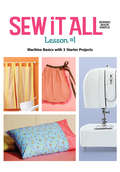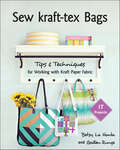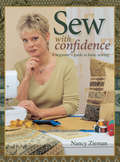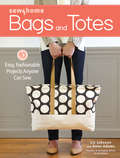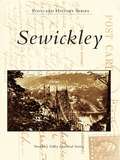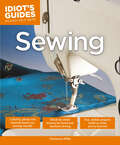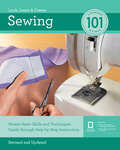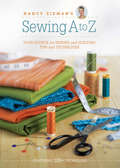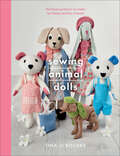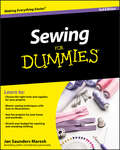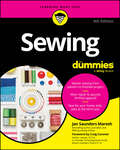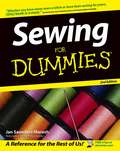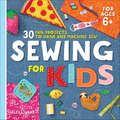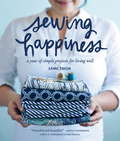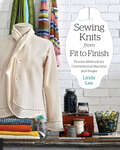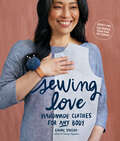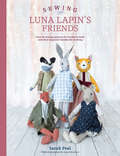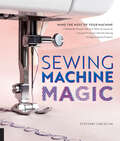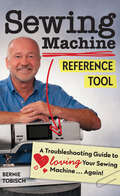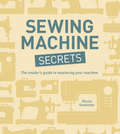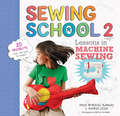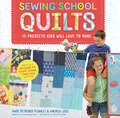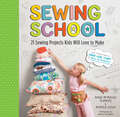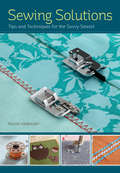- Table View
- List View
Sew it All Lesson #1
by Ellen MarchPart of the Sew it All ebook series, Lesson #1 gets up close and personal with sewing machines. Three simple projects are included that put your sewing machine skills to good use: a pillowcase, curtains and hat.
Sew kraft-tex Bags: Tips & Techniques for Working with Kraft Paper Fabric
by Gailen Runge Betsy LaHontaIt’s the hot new substrate that wears like leather but sews up like fabric—create more with kraft-tex! This game-changing material is the perfect accent for wallets, totes, and purses. Don’t fall into the same traps as beginning bag-makers. Experts Betsy La Honta and Gailen Runge use their design skills to teach you everything about sewing with kraft-tex. Get your needle know-how, sew the right seam allowances, and practice turning techniques. Popular bag designers share seventeen patterns for all skill levels, from a simple clutch to a roomy travel bag. Bags for every skill level! Seventeen patterns from top designers reimagined in kraft-tex Sew purses, totes, wallets, and more with fashionable kraft-tex accents Avoid common mistakes! Add vegan leather to any bag pattern, with tips from kraft-tex experts Betsy LaHonta and Gailen Runge
Sew with confidence: A Beginner's Guide to Basic Sewing
by Nancy ZiemanLet Nancy Zieman Help You Sew with Confidence Do you think sewing is difficult? You won't after you read this book! Written for beginners by Nancy Zieman, host of the popular PBS television seriesSewing with Nancy, this guide provides all the help you need to sew like a pro. The friendly, easy-to-understand instruction starts with the basics and continuities through the process until you can easily sew all of the projects included. Clear step-by-step directions with lots of illustrations ensure your success. You'll find information on: Tools - Cutting, Measuring, Marking, Pressing Sewing Machines and Sergers Fabrics and Interfacings Patterns and Alternations Layout, Cutting, Marking, Stitching Waistlines, Gathering, Darts, Pleats, Sleeves Zippers, Hems, Closures, Pockets Step-by-step Directions for: curtains, pillows, pants, totes/gift bags
Sew4Home Bags and Totes: 10 Easy, Fashionable Projects Anyone Can Sew
by Anne Adams Liz JohnsonCreate cool carryalls--no pattern required! Hit the town, office or schoolyard with these one-of-a-kind bags and totes! In this handy beginner's guide, the experts behind Sew4Home.com show you how to create ten hip projects, from clutches and shoulder bags to a slick yoga mat sling and a vintage kids' book bag. No paper patterns required! Throughout Sew4Home Bags and Totes, you'll find step-by-step instructions and sewing tutorials. Learn to make ruffles, fussy cut fabric, add an inset zipper, and other design details to give your bag a professional finish. Thanks to authors Liz Johnson and Anne Adams, learning to sew trend-setting bags and totes has never been easier or more fashionable!
Sewickley (Postcard History Series)
by Sewickley Valley Historical SocietyWith its prime location along the Ohio River downstream from Pittsburgh, Sewickley was destined to become a great American town. In 1753, a young George Washington traveled through the area on his way to inform the French that the British crown would not tolerate French trespass in the Ohio Valley. Meriwether Lewis mentioned the obstacle presented by its waterfront eddies in his 1803 journal. Eventually the area became home to river men, including the captains of steamers that plied the Ohio. After the arrival of the railroad, many of the railroad brass made their homes in Sewickley. With the automobile came the industrial barons of Pittsburgh, who erected their palatial summer "cottages" on Sewickley Heights. The town learned quickly to adjust to celebrities, taking in stride the likes of iron pioneers Henry Oliver and Benjamin Franklin Jones, author Mary Roberts Rinehart, composer Ethelbert Nevin, and Capt. Frederick Way Jr. Using historic postcards, Sewickley illustrates the history of this community, which maintains its status as the queen of Pittsburgh suburbs.
Sewing (Idiot's Guides)
by Cinnamon MilesBecome more than so-so at sewing!Whether you want to make a quilt, re-upholster a chair seat, or fix a hem, sewing is one of the most essential and useful skills you can master. But if you've never even turned on a sewing machine before, learning to sew can seem like a daunting task. Not anymore! Geared toward the absolute beginner, Idiot's Guides: Sewing teaches the basics of sewing in a series of lessons using full-color, step-by-step illustrated instructions that enable you to clearly see how every technique is executed, from threading a sewing machine to reading a pattern. The lessons are accompanied by practice projects, allowing you to try out their newly learned skill. As the lessons become more advanced, so do the projects, giving you instant gratification as you become more proficient. This completely illustrated guide is an essential tool for any person who wants to learn to sew. Features include:• Tailored to the beginner who has never used a sewing machine before, with clear, easy-to-understand instructions. • Comprehensive, step-by-step, color instructions teach all the basic techniques of sewing, from threading a machine to various stitches and construction. • Practice projects throughout help the reader learn and practice techniques. • Handy guides teach how to read a pattern, choose and prepare fabrics, create seams and finishes, and more.
Sewing 101: Master Basic Skills and Techniques Easily Through Step-by-Step Instruction (Look, Learn & Create)
by Creative Publishing internationalA complete entry-level sewing course taught through twenty step-by-step projects for garments and home décor.Have you always wanted to try sewing but aren’t sure where to begin? Sewing 101 teaches you everything you need to know for successful machine sewing:The Basics gives you a firm foundation for learning to sew, offering essential guidance for your sewing machine, fabrics, patterns, and supplies.The Projects are arranged progressively, from simple garments like T-shirts, skirts, and aprons, to more challenging home décor items such as a blankets, tablecloths, and Roman shades. Each project introduces and explores new sewing skills in depth—and variations will inspire you to create your own designs.Beginners will also find the accompanying online videos that present the techniques in action an invaluable resource. Written specifically for beginners, the books in the 101 series are complete illustrated guides to the basics of a craft that present projects supported with full-color, step-by-step instructions and photos to teach essential techniques.
Sewing A to Z: Your Source for Sewing and Quilting Tips and Techniques
by Nancy ZiemanThe Answers to All Your Sewing Questions! Whether you’re a novice sewer or a skilled seamstress, who better to go to for sewing answers and advice than expert Nancy Zieman? Set aside your sewing fears and let Nancy guide you step-by-step through 100+ basic to advanced sewing methods and techniques. § Arranged in alphabetical order for fast and easy reference, this handy guide will make its permanent home by your sewing machine or on your workspace. § With over 100 topics ranging from Appliqué to Zippers, Nancy will help you achieve beautiful results with every project. § HelpfulNotes from Nancythroughout the book provide insights and tips for a variety of sewing techniques and skills. § Spiral binding allows the book to lay flat for hands-free reference while you sew, cut or press. § Clear, concise instructions and detailed illustrations help make even the most advanced techniques easy to understand and successfully execute. A wealth of information and instruction from your favorite sewing expert is at your fingertips in this go-to guide! Stitch with ease and assurance withNancy Zieman’s Sewing A to Zby your side!
Sewing Animal Dolls: Heirloom Patterns to Make for Daisy and Her Friends (Crafts Ser.)
by Tina O'RourkeThe founder of Miss Daisy Patterns has crafted &“a great book if you want to get into the world of making animal dolls and wardrobes of clothes for them (Blackberry Garden).Learn how to make Daisy Dog, her best friends Rosie Rabbit, the twins Betty and Ben Bear and Daisy&’s beret wearing puppy, Mimi. Each character has their own complete wardrobe for all of their adventures together, from playing dress up to long summer picnics, sleepovers and weekend walks.Sewing Animal Dolls features easy to follow step-by-step instructions with full-size sewing patterns for all of the characters, clothes and accessories.&“This beautiful collection of handmade dolls is sure to be cherished for years to come!&” —Handmade by Deb&“This book is such an adorable, inspirational guide on sewing some cute friends! They are very well put together with patterns to allow the reader to sew up the same animal as seen on the cover and through the book.&” —Inspired2Craft &“Not only are the dolls great to make for yourself they also make wonderful gifts.&” —Blackberry Garden
Sewing For Dummies
by Jan Saunders MareshThe most complete guide to sewing basicsPeople are always looking for ways to cut expenses and be creative and stylish at the same time. Learning to sew is a great way to arm yourself with the skills to repair and create clothing and furnishings for yourself and your family for little to no cost. But learning how to sew and how to choose the tools and supplies to begin sewing can be confusing.Now, you can turn to this hands-on, friendly guide for the most up-to-date information, the best techniques, and fun projects for learning (or brushing up on) the art of sewing.Easy-to-follow instructions and step-by-step illustrations make it easier to learnFresh new patterns, projects, stitches, and techniques for fashion and the homeBudget-conscious tips for breathing new life into existing garmentsComplete with a section on common sewing mistakes and how to avoid them, Sewing For Dummies, 3rd edition gives you the confidence and know-how to sew like a pro.
Sewing For Dummies
by Jan Saunders MareshLearn the basic skills and techniques you need for successful hand and machine sewing Over the past ten years, interest in sewing has grown. If want to learn how to sew or to improve your skills, Sewing For Dummies is the book you need to get started. This complete guide to sewing basics teaches you basic hand stitches and sewing machine operation, with easy-to-follow instructions and step-by-step illustrations. You'll work your way forward to develop the skills to create or repair clothing and furnishings that fit your personal style, your measurements, and your aesthetic. Find great patterns in stores and online, give thrift store finds new life, and learn about cool new fabrics and sewing trends. You'll also get an overview of common sewing mistakes and how to avoid them, so you can take up this relaxing, creative hobby with confidence. A full-color insert brings the text to life. Enjoy the feeling of accomplishment you'll get when you use your new skills to create wonderful handmade pieces. Learn hand and machine sewing skills, starting with the basics and working your way up Choose the right sewing machine for your needs and follow step-by-step tutorials to master its use Makes repairs and alterations to keep your wardrobe current Learn about online sewing resources and get ideas for finding fabric and patterns This Dummies guide will help anyone who wants to learn basic sewing skills or brush up on what they already know. Sew a button back on your jacket, make pillowcases from an old dress, alter that great vintage dress to fit like a glove, and complete any other sewing projects you can dream up.
Sewing For Dummies, 2nd Edition
by Jan Saunders MareshDo you love to sew-or want to learn how? Then this book will have you in stitches in no time. There's nothing like the feeling of completing a project using beautiful fabrics and great timesaving tools and then sharing it with your family and friends. Plus, learning to sew will save you money too! Before long, you'll be stitching your own hems, repairing split seams, sewing on buttons, and much, much more. Sewing For Dummies is a book for both absolute beginners and experienced sewers. If you're a stone-cold beginner, you'll find everything you need to know to sew beginning-level projects-and the book doesn't assume that you've ever even picked up a needle and thread before. If you've had some experience with sewing, you'll find tips and tricks that it took author Janice Saunders Maresh, a nationally known sewing and serging instructor, years to pick up! You'll discover how to: Master hand and machine stitches Read a sewing pattern Hem a variety of fabrics Negotiate sleeves and pockets Install zippers, buttons, and other fasteners Shape garments with tucks and pleats Adjust projects for better fit and function This updated edition features a fresh 8-page color insert of all the new home decorating projects, including new patterns and instructions for a traditional living room with slipcovered couches and throws; a French country dining room with drapes and slipcovered chairs; and a bedroom with shams, duvets, dustruffles, and window treatments, as well as: a bathroom with a shower curtain and towels hip and funky tote bags the perfect little black dress Complete with lists of quick fix-it tools, sewing fundamentals, and sewing resources, Sewing For Dummies, 2nd Edition, is the fun and easy way® to get the basics and stitch up a storm in no time!
Sewing For Kids: 30 Fun Projects to Hand and Machine Sew
by Alexa WardGet the book that's on every crafty kid's gift list—super fun sewing projects for kids ages 6 to 9!From an adorable Needle House to an awesome Pizza Pencil Case, there are so many things that can be sewn with just a needle and thread. Packed with beginner techniques for both hand sewing and machine sewing, Sewing for Kids takes you stitch-by-stitch from threading a needle to making your own Fingerless Gloves.Get started with the ins and outs of hand sewing, like how to tie a knot or sew a whipstitch, and before you know it, you'll be sewing on a sewing machine! Wow your friends with your own hand-sewn Fruit Purse—then, take your sewing up a notch with machine projects like a Winter Beanie and Shark Tail Blanket.Sewing for beginners—Start stitching with easy-to-understand techniques, safety rules, basic stitches to build on, and tips for filling your sewing kit.Something for everyone—These fun and funky hand-sewing and machine-sewing projects increase in difficulty so you can get comfortable sewing and then practice your skills.So much to choose from—Have a blast sewing handmade goods, like a Sloth Backpack Charm, a Tic-Tac-Toe Pillow, and a Beanbag Chair—and customize your crafts with tips to make them your own.With this sewing book for kids, you'll have tons of fun and learn an impressive skill you'll use for the rest of your life.
Sewing For The Soul: Simple sewing patterns and recipes to lift the spirits
by Jules FallonThe benefits of sewing are well known and these sewing projects designed to soothe your spirit also gives you the satisfaction of creating new clothes.Sewing is good for the soul and this collection of relaxed garments, accessories and loungewear sewing patterns is designed to soothe the soul and lift the spirits. But this book isn't just about the clothes, it's about the power of sewing to help you relax and unwind: there are smaller projects for hand sewing, the ultimate mindful craft, and quick dressmaking patterns for times when you want a sewing 'fix' but are a bit pushed for time.As well as the sewing projects there is also a smattering of delicious recipes to feed more than just the soul! Sewing and baking have always been natural bed fellows and this collection features garments, cakes and drinks to celebrate every season whether it's 'Mullered Wine' in the winter or a delicious Lemon Drizzle Cake for the summer.There are full-size, graded patterns (up to a UK size 26/US size 22) for ten easy-to-wear garments including pyjama pants, a linen T shirt, a summer dress and palazzo pants. This means that you can find your perfect size and get sewing straight away without having to print out the patterns. The designs are for relaxed-fit clothes and 'loungewear', which are suitable for both work and home and all the garment instructions have written step-by-steps and diagrams making them suitable for all abilities.
Sewing Happiness: A Year of Simple Projects for Living Well
by Sanae IshidaTwenty simple sewing projects are tied together with a thread of memoir that tells the story of how sewing brought Sanae Ishida profound happiness. Each seasonal project, specially designed to promote health, creativity, relationships and more, provides gentle inspiration to live your best life. When Ishida was diagnosed with a chronic illness and lost her corporate job, she thought her life was over. But these challenges ended up being the best thing that ever happened to her because they forced her to take stock of her life and focus on the important things, and enabled her to rediscover sewing--her true passion. Inspired to succeed at just one thing, Ishida vowed to sew all of her daughter's clothes (and most of her own) for one year. Sewing Happiness includes 20 projects plus variations (including Japanese-inspired home goods and children's and women's clothing) organized by season, and stitched together with Ishida's charming personal story.
Sewing Knits from Fit to Finish: Proven Methods for Conventional Machine and Serger
by Linda LeeSew what you love to wear and make it as professionally as you possibly can with this comprehensive look at the world of knits.Sewing your own clothes is rewarding and cost-effective, plus it’s an enjoyable creative skill to develop. Sewing Knits from Fit to Finish gives you the instruction you need to sew soft knit fabrics using professional techniques. This comprehensive reference book from expert Linda Lee includes methods for both conventional sewing machines and sergers, and it includes precise construction notes and how-to photos along the way.Sewing Knits from Fit to Finish eases readers into the subject by teaching how to identify the different types of knit fabrics available and helping them select the ones that best suit their sewing projects. From there, the book introduces readers to sewing patterns for knit fabrics and teaches how to tweak those patterns to fit specific measurements. After that, Sewing Knits from Fit to Finish moves step-by-step through the sewing process, including all of the following:Preparing fabric before it’s cutTransferring pattern markings onto knit fabricsOrganizing a garment’s constructionSewing seams and selecting seam stylesUtilizing stabilizers and inserting closuresSewing a hem and selecting a hem styleAdding embellishments to create a more unique garmentImagine an updated wardrobe that you have total control over. Sewing Knits from Fit to Finish makes that dream a very possible reality. Not only that, the book reveals a few shortcuts and troubleshooting tips to ensure a stress-free sewing process. So jump on the sewing bandwagon! Once you learn how to sew knit-fabric pieces, you’ll wonder why you ever bought them.
Sewing Love: Handmade Clothes for Any Body
by Sanae IshidaLearn to sew beautiful, simple handmade clothes and begin a journey to loving the body you have.Draft patterns and sew clothes that fit your unique body! In this garment-making primer, sewing is an act of radical kindness and self-care. Learning to sew for yourself enables you to make exactly the kinds of clothes you want, and empowers you to solve the fit issues that come with buying commercial clothing designed to fit one "ideal" body type. Sanae Ishida, author of the award-winning Sewing Happiness, guides you through the process with her inspiring personal story and gentle instruction in the simple art of pattern-making and garment sewing. Create a complete capsule wardrobe of tops, bottoms, dresses, tunics, and outerwear. Each of the 15 projects (including variations) is designed to look good on a wide variety of body types—they're fashionable yet timeless, and let you move with ease. Every pattern is self-drafted (no printed pattern sheets here—you will learn to draft and customize basic shapes to your own body measurements for a comfortable fit). Patternmaking has never been easier than in this intuitive, fully illustrated book.Includes:Lookbook with photographs of the projects on diverse modelsPrimer on basic sewing, pattern drafting (slopers and muslins), and fittingStep-by-step illustrated instructions for all 15 projects and variationsHeartwarming personal essay on the author's journey to body positivity
Sewing Luna Lapin's Friends: 20 Sewing Patterns for Heirloom Dolls and Their Wonderful Wardrobes
by Sarah Peel Grace MachonSew the squad! Create the fashionably attired stuffed animals Reynard the Fox, Clementine the Cat, Freddie the Badger, and Wilhelmina the Mouse.Learn to make Luna Lapin’s friends and their exquisite wardrobes. This collection of sewing patterns features four of Luna’s best friends and their clothes including a fox, a cat, a badger, a mouse, and even a baby Luna!Author Sarah Peel takes classic garments and recreates them on a miniature scale and with exquisite fabrics including Liberty cottons, wool tweed and French lace.Full sized patterns and step-by-step instructions are included—as well as a collection of charming stories about the characters and their adventures.Praise for Making Luna Lapin“[The] cutest of Heirloom Hares . . . The book is a little treasure; it’s beautifully photographed throughout and contains some sweet stories.” —Sew Sarah Smith“If you’re into sewing super cute softies with big personalities, this book might just be up your ally . . . [a] gem.” —Studio iHanna
Sewing Machine Magic: Make the Most of Your Machine
by Steffani LincecumSewing machines are complicated machines, but with this book you can unravel their mysteries—and make even an old sewing machine work wonders.With just a little know-how and the right accessories, you can get the most out of your sewing machine and give all your sewing and quilting projects a professional look!In Sewing Machine Magic, designer and sewing instructor Steffani Lincecum shares more than thirty years of experience on how to handle a sewing machine with greater ease and confidence, and explains how to easily find and use the right presser feet and other accessories for your machine, whether you purchased it at retail or found it at a yard sale.You’ll learn the logistics of managing thread, how to achieve the proper stitch formation for every project, and how to troubleshoot a variety of common sewing problems. Learn to use more than thirty presser feet and other accessories, from the basics to more specialized tools designed to maximize efficiency, precision, and creativity. In addition, the ten fashion and home decor projects included here show inventive ways to use some of the feet and accessories. Master your machine with a teacher who has sewn for film, TV, and theater productions and shared her expertise on PBS and Craftsy!
Sewing Machine Reference Tool: A Troubleshooting Guide to Loving Your Sewing Machine ... Again!
by Bernie TobischEasily solve a multitude of sewing machine problems with this handy guide.Kick tension problems to the curb and say goodbye to presser foot problems! This pocket-size guide helps you troubleshoot your sewing machine on the go. A comprehensive chart of common issues will help you quickly diagnose the issue at hand and find the remedy to get your stress levels back to zero. Master needle nicks, tricky threaders, and baffling buttonholes once and for all! This portable guide is perfect to take along to retreats and classes so readers can quickly get their machines back up and running.All the information you need to resolve common issues for stress-free sewingQuickly find the facts with a troubleshooting chart for sewers and quiltersSolve tension and presser foot problems, mastering buttonholes, needles, threaders, automatic thread cutters, and more
Sewing Machine Secrets: The Insider#s Guide to Mastering your Machine
by Nicole VasbinderGet the most out of your sewing machine and learn tips and tricks from an expert! Sewing Machine Secrets is an indispensable resource for sewers of all levels, showing you how to choose, use, and maintain your sewing machine, master essential sewing techniques, and learn handy tips along the way. The book is divided into two sections. Section one provides an overview of each type of sewing machine, instructions on how to use it, and detailing its advantages and limitations, necessary accessories and optional accessories, parts, and maintenance. Section two uses a more technique-based approach, identifying the most versatile and commonly used presser feet and providing step-by-step techniques for all the results you can achieve using them. Sewing Machine Secrets will teach you the tried and tested tricks you need to get the most out of your machine.
Sewing School 2: Lessons in Machine Sewing; 20 Projects Kids Will Love to Make (Sewing School)
by Andria Lisle Amie Petronis PlumleyFor kids who have mastered hand sewing, machine sewing opens up exciting new possibilities! Sewing School 2 offers 20 creative projects designed for children ages 7 and up, including cloth pencil cases, purses, wall pockets, and even a fabric guitar. Illustrated step-by-step instructions show kids how to thread a sewing machine, select an appropriate stitch, and choose fabrics and patterns that evoke their own unique style. Suggestions for creative variations open up endless possibilities for kids to imaginatively personalize their fabric creations.
Sewing School Quilts: 15 Projects Kids Will Love to Make; Stitch Up a Patchwork Pet, Scrappy Journal, T-Shirt Quilt, and More (Sewing School)
by Justin Fox Burks Andria Lisle Amie Petronis PlumleyThe best-selling authors of the Sewing School series are back, introducing kids to the creativity of stitching patchwork, appliqué, and quilts. Using dynamic how-to photos and step-by-step instructions written for ages 8 to 12, Amie Petronis Plumley and Andria Lisle teach a variety of techniques using both hand and machine sewing. The 15 projects range from decorative to practical, including an appliquéd family crest wall hanging, a patchwork pet bed, a crazy-quilt journal cover, and a quilt made from recycled T-shirts. Every project features encouraging suggestions for making truly one-of-a-kind items that express the creative spirit of each young maker.
Sewing School: 21 Sewing Projects Kids Will Love to Make (Sewing School)
by Andria Lisle Amie Petronis PlumleyKids can sew too! This inspiring guide includes 21 fun sewing projects for children ages 5 and up. With easy-to-follow illustrated instructions and cut-out patterns, young crafters will quickly be sewing up colorful pillows, potholders, dolls, blankets, and more. These kid-tested projects require only minimal supervision and most can be made using simple hand stitches, so no sewing machine is required. With plenty of encouragement and helpful tips, Sewing School helps little sewers develop their skills while sparking a passion that will last a lifetime.
Sewing Solutions: Tips and Advice for the Savvy Sewist
by Nicole VasbinderEven the best sewists will encounter problems, snags, and little glitches in their work. Expert sewist and author Nicole Vasbinder's Sewing Solutions is an indispensable reference filled with invaluable advice you can trust. Organized by stages, you'll find: Detailed advice for the sewing process, including pros and cons, and basic considerations of working in each step. An easy-to-follow layout providing basic information as well as step-by-step techniques for making bias tape, sewing trims, buttonholes, zippers, hems, and more. Easy-tonavigate color-coded cross-references available for quick referencing. Troubleshooting tips that advise how to deal with every sewing situation. Whether choosing the right tools, reading patterns correctly, or everything in between, Sewing Solutions will prove to be an essential sewing companion.
